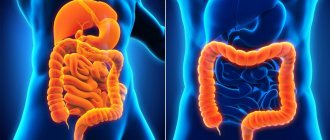Vomiting is a forced, uncontrolled expulsion of stomach contents
or intestines through the mouth with the participation of the abdominal muscles and diaphragm. Vomiting is also accompanied by weakness, drooling, watery eyes and dizziness. Both the feeling of nausea and vomiting are triggered by a special nerve center located in the brain stem. The signals come from sensitive receptors in the digestive tract, so irritation of these receptors triggers the gag reflex. Irritation of the sensitive receptors of the gag reflex occurs, for example, with strong stretching of the walls of the stomach, with eating foods with an irritating effect, with inflammation of the walls of the stomach and intestines (gastritis, gastroenteritis). Direct irritation of the “vomiting center” can also cause vomiting, even if there is no irritation from the digestive tract. This phenomenon is observed in various diseases of the nervous system.
general characteristics
At the time of vomiting, the patient experiences an uncontrolled contraction of the abdominal muscles and diaphragm, leading to a sharp release of gastric and, in some cases, intestinal contents.
The secreted masses may contain remnants of undigested food, mucous, bloody and bile inclusions, and other pathological impurities. Often the attack is preceded by nausea, profuse salivation, weakness, and sweating. Possible dizziness, unsteadiness of gait, rapid heartbeat. After an episode of vomiting, a sour, bitter, putrid taste or odor remains in the mouth and sometimes in the nasal passages. From the outside, the patient looks confused, pale, and beads of sweat are often visible on the forehead. The appearance of vomiting should always be regarded as a threatening condition that requires a medical examination. If the patient’s condition has improved after the vomit has passed, a visit to a general practitioner or family doctor may be scheduled. If indomitable vomiting occurs, blood, bile, mucus and feces are detected in it, the symptom is combined with hyperthermia, intense pain of any localization, diarrhea, stupor, disorientation and convulsions, you must call an ambulance.
Complications
Persistent R. causes a number of metabolic changes in the body. Frequently repeated R., especially in children, the elderly, and debilitated patients, causes dehydration (see Dehydration), hypovolemia (see Oligemia), hypokalemia (see), hyponatremia (see), hypochloremia (see) with the development of metabolic alkalosis (see). These metabolic disorders lead to disturbances in cardiac activity, kidney function, and sometimes to disorders of consciousness and paralysis. Hematocrit indicators increase, the level of renin and aldosterone in plasma increases, creatinine clearance decreases, and the content of residual nitrogen in the blood increases (chloroprivate uremia). Prolonged and severe R. can cause the formation of tears in the mucous membrane, most often in the area of the transition from the esophagus to the stomach, with massive bleeding - the so-called. Mallory-Weiss syndrome (see Mallory-Weiss syndrome). In weakened individuals (especially children and the elderly), as well as in patients with impaired consciousness, aspiration of vomit is possible with subsequent additional complications.
Development mechanism
Vomiting is the result of a complex reflex reaction in which the uncontrolled contraction and relaxation of various muscle groups leads to the release of gastric chyme. The reflex is activated by influences on different links of the neural chain. Neuroreceptors that stimulate the vomiting center are located in the pharynx, stomach, intestines, bile ducts, peritoneum, coronary and mesenteric vessels, and a number of other organs. Their activation causes irritation of the mucous membranes with bacterial toxins, release of bioactive substances, pressure, vasospasm, and other visceral effects.
Impulses from peripheral receptors travel through vagal and sympathetic fibers to the vomiting center of the medulla oblongata. Neurons of the reticular formation can also be activated by the direct influence of toxic substances on the chemosensitive zone of the bottom of the fourth cerebral ventricle and by an increase in intracranial pressure. Less commonly, the gag reflex is triggered by impulses from the vestibular apparatus, exposure to mental stimuli, or intense pain of any origin.
The motor part of the reflex arc is represented by V, IX, X pairs of cranial nerves innervating the soft palate, larynx, pharynx, esophagus, stomach and diaphragm, spinal nerves providing contraction of the striated intercostal muscles and the muscles of the anterior abdominal wall. Since the vomiting center is located next to the cough, vasomotor, respiratory and other autonomic centers, their simultaneous activation causes hypersalivation, a drop in blood pressure, pallor and other parasympathetic reactions.
When efferent impulses arrive against the background of deep inspiration, the diaphragm lowers, the epiglottis closes the entrance to the respiratory tract, the larynx and palate rise, preventing the reflux of chyme into the trachea, bronchi and lungs. Tension of the diaphragmatic and abdominal muscles against the background of compression of the pylorus and relaxation of the cardia provides an increase in intra-abdominal and intragastric pressure, which ends in an attack of vomiting. In some conditions, antiperistaltic movements of the intestinal wall occur, causing intestinal contents to enter the stomach and then into the vomit.
Which doctor should I contact?
To diagnose a disease manifested by vomiting, you need to contact a gastroenterologist or therapist. If the symptom is central vomiting, it is quite possible that you will need to consult a neurologist, and for psychogenic vomiting, a psychotherapist.
Treatment of vomiting is impossible without a thorough diagnosis of the underlying disease and treatment of its manifestations. Manifestations of the gag reflex should not be ignored; they can be a symptom of dangerous pathologies.
Author of the article:
Alekseeva Maria Yurievna |
Therapist Education: From 2010 to 2021 practicing physician at the therapeutic hospital of the central medical unit No. 21, the city of Elektrostal. Since 2021 he has been working at diagnostic center No. 3. Our authors
Classification
When systematizing the clinical variants of a symptom, its connection with gastrointestinal diseases, the frequency of manifestation, the mechanism of development, and the characteristics of vomit are taken into account. Vomiting associated with diseases of the digestive tract is called primary, and vomiting that occurs against the background of other pathological conditions is called secondary. Depending on the leading mechanism of development, the following are distinguished:
- Central vomiting
. It is observed in the presence of cerebral pathology (inflammation of the brain matter and membranes, increased intracranial pressure due to head injuries, brain tumors). In neuroses, panic attacks, migraines, hyperthermia, the symptom is associated with dysfunction of the central links of autonomic regulation. It often occurs repeatedly and does not alleviate the patient’s condition. - Hemotoxic vomiting
. It is caused by irritation of the receptor zone of the medulla oblongata during the circulation of various exo- and endotoxins in the blood. It is found in cases of poisoning with medications, toxic products and reagents. It is an unfavorable sign of intoxication in the presence of severe and terminal conditions (malignant tumors, renal, liver failure). - Reflex vomiting
. Caused by irritation of the visceral receptors of the arc of the gag reflex in various organs and tissues. It most often develops in gastrointestinal pathology, but can be provoked by pathological afferentation in diseases of the ENT organs, heart, lungs, bronchi and female reproductive system. Variants of reflex vomiting are psychogenic and vestibular.
The symptom can appear once (usually against the background of food errors, poisoning, intestinal infections), repeatedly (several times in a short time, up to uncontrollable vomiting in severe intoxication and cerebral disorders), periodically (with gastrointestinal diseases, other chronic pathologies). From a diagnostic point of view, it is important to take into account the nature of the vomit. According to the characteristics of the impurities, there are variants of vomiting of undigested food, blood (scarlet and the color of coffee grounds), bile, foamy mucus, and intestinal contents.
Content
- 1 Complications 1.1 Aspiration
- 1.2 Dehydration and electrolyte imbalance
- 1.3 Mallory–Weiss Tear
- 1.4 Dentistry
- 2.1 Phases
- 3.1 Digestive tract
- 6.1 Social signals
Causes of vomiting
Causes of vomiting bile
Vomit mixed with bile has a greenish color; after vomiting, a bitter taste is felt in the mouth, and a yellow-green coating remains on the tongue. Vomiting bile may be a sign of the following pathological conditions:
- Diseases of the hepatobiliary system
: cholelithiasis, cholecystitis and cholangitis, biliary dyskinesia. - Duodeno
-
gastric reflux
: acute and chronic duodenitis, duodenal stenosis, functional dyspepsia. - Pathologies of the pancreas
: chronic pancreatitis, cysts and tumors. - Helminthic infestations
: opisthorchiasis, giardiasis. - Acute surgical diseases
: initial phase of peritonitis and acute intestinal obstruction, appendicitis. - Alcohol intoxication
.
Causes of food vomiting
Nausea and vomiting may occur at various times after eating. Remnants of what was eaten are clearly visible in the vomit. The most common causes of food vomiting are:
- Poisoning
: food poisoning, salmonellosis, escherichiosis, etc. - Stomach diseases
: acute gastritis, pyloric stenosis, neoplasms. - Damage to the esophagus:
various types of dyskinesia, congenital or acquired stenosis, ulcerative defects. - Other gastroenterological pathologies:
duodenal stenosis, afferent loop syndrome.
Causes of vomiting blood
Vomit like “coffee grounds” or mixed with fresh blood always indicates bleeding from the gastrointestinal tract. Vomiting blood occurs in the following diseases of the digestive tract:
- Peptic ulcer
: bleeding from the bottom of the ulcer, Zollinger-Ellison syndrome. - Gastritis:
erosive, hemorrhagic. - Pathology of the gastroduodenal zone:
diverticula, acute dilatation of the stomach, erosive bulbitis. - Stomach tumors.
- Diseases of the esophagus:
Mallory-Weiss syndrome, acute esophagitis, esophageal cancer. - Portal hypertension:
bleeding from varicose veins. - Complications of pharmacotherapy:
long-term use of NSAIDs, anticoagulants, corticosteroids. - Rare causes:
hemorrhagic syndromes, neurotoxicosis, excessive nosebleeds.
Causes of vomiting during pregnancy
Nausea and vomiting in pregnant women can occur both due to gestation itself and changes occurring in the body, and in the case of the development of various pathologies. Possible reasons:
- Early toxicosis
. - Gastrointestinal diseases
: GERD, gastritis and duodenitis, functional stomach disorders, hiatal hernia. - Specific pathology of pregnancy
: cholestasis, hypothyroidism, polyneuropathy of pregnancy.
Causes of fecal vomiting
Vomiting of intestinal contents is always a sign of surgical pathology that requires an urgent response. Fecal vomiting can occur under the following conditions:
- Intestinal obstruction
: obstructive and strangulation forms. - End stage peritonitis
. - Gastrointestinal fistulas.
When medical attention is needed
Call an ambulance if nausea/vomiting is accompanied by:
- severe or increasing abdominal pain;
- chest pain;
- high temperature;
- neck muscle tension;
- anuria (lack of urine, less than 100 ml per day);
- confusion, unconsciousness;
- dehydration;
- numbness and paralysis of the limbs, asymmetrical smile and speech problems;
- vomiting feces or blood;
- uncontrollable vomiting.
Make an appointment with a doctor at the First Family Clinic of St. Petersburg if:
- in an infant, vomiting does not stop for 12 hours, in a child under 2 years old - 24 hours, in an adult - more than 2 days;
- nausea and vomiting occur at least once a week for 1 month;
- nausea and vomiting are accompanied by weight loss.
Diagnostics
The development of vomiting is most often caused by diseases of the gastrointestinal tract, so a comprehensive examination is carried out by a gastroenterologist. A diagnostic search involves studying the structural and functional features of the digestive system and excluding concomitant pathologies. The most informative for identifying the causes of vomiting:
- Endoscopy.
Using the method of visualizing the mucous membrane of the upper gastrointestinal tract, a specialist can see inflammatory changes, foci of epithelial destruction, and voluminous neoplasms. If necessary, during endoscopy, a biopsy of individual sections of the mucosa is performed for subsequent cytomorphological diagnosis. - X-ray methods
. Radiography with contrast is highly informative for organic diseases, which are often manifested by vomiting. The images can reveal deformation of the contours of the esophagus or stomach, and pathological shadows. The speed of contrast advancement is used to judge the motor function of the digestive tract. - Ultrasonography
. A survey ultrasound of the abdominal cavity is prescribed to all patients with dyspeptic disorders as a screening method. Sonography allows you to identify nonspecific signs of the inflammatory process and changes in the organs of the hepatobiliary system. The method is used to diagnose gastrointestinal pathologies in pregnant women at any stage. - Esophageal manometry
. Measurement of esophageal pressure is performed to exclude dyskinesia and dysfunction of the muscle sphincters, as the main cause of vomiting. If hyperacid diseases of the stomach are suspected, daily pH measurements are prescribed. Intraesophageal pH determination is indicated for the verification of GERD. - Lab tests
. In the coprogram, characteristic changes can be detected: undigested food components, the presence of fecal elastase. Stool culture is recommended to exclude intestinal infections. Biochemical blood test indicators are also assessed: acute phase proteins, levels of bilirubin and liver enzymes.
In case of damage to the hepatobiliary system, duodenal intubation with microscopic examination of bile and targeted ultrasound of the liver and gallbladder are recommended. If vomiting is caused by an infectious process, serological tests are performed to determine the type of pathogen and the amount of specific antibodies. A gynecologist is required to examine pregnant women. Once all organic causes have been ruled out, autonomic nervous system testing may be necessary.
For profuse vomiting, give oral or parenteral rehydration
Recommendations
- Tintinally, Judith E. (2010). Emergency Medicine: A Comprehensive Guide (Emergency Medicine (Tintinally))
. New York: McGraw-Hill Companies. item 830. ISBN 978-0-07-148480-0. - K. L., Koch (2000). "Unexplained nausea and vomiting." Current treatment options in gastroenterology
.
3
(4): 303–313. doi:10.1007/s11938-000-0044-5. PMID 11096591. - "The New Eating Disorder: No Binging, Just Purging." September 20, 2007
- Holland, James F.; Kufe, Donald W.; Weichselbaum, Ralph R.; Pollock, Raphael E.; Frey III, Emil; Gansler, Ted S.; Bast Jr., Robert S. (2003). Anticancer medicine
(6. [ed.]. Ed.). Hamilton, Ontario [ua]: Decker. ISBN 9781550092134. - Hornby, P.J. (2001). "A central neural network associated with vomiting." American Journal of Medicine
. 111 App. 8A(8): 106S–112S. Doi:10.1016/S0002-9343(01)00849-X. PMID 11749934. - Naylor, R.J.; Inal, F. C. (January 1994). "Physiology and pharmacology of postoperative nausea and vomiting." Anesthesia
. 49 Addendum: 2–5. Doi:10.1111/j.1365-2044.1994.tb03575.x. PMID 8129158. - Matsuoka, I; Ito, J; Takahashi, H; Sasha, M; Takaori, S (1984). "Experimental vestibular pharmacology: a mini-review with special emphasis on neuroactive agents and drugs for vertigo." Acta Oto-Laryngologica Supplementum
.
419
: 62–70. PMID 6399658. - Li – gui, Huang; En – tong, Wang; Wei, Chen; Wei-si, Gong (June 2011). "The role of histamine H1 receptors in the vestibular nucleus in movement disease". Journal of Otology
.
6
(1): 20–25. Doi:10.1016/S1672-2930(11)50003-0. - Ray Andrew P.; Chaebolu Sita; Ramirez Juan; Darmani Nissar A (2009). "Deleting the smallest central shrew neurokinin receptor NK1 reduces GR73632-induced vomiting." Behavioral Neuroscience
.
123
(3):701–706. doi:10.1037/a0015733. PMC 2714262. PMID 19485577. - Balaban CD, Yates BJ (January 2021). “What is nausea? A Historical Analysis of Changing Attitudes." Autonomic Neuroscience
.
202
: 5–17. Doi:10.1016/j.autneu.2016.07.003. PMC 5203950. PMID 27450627. - W. S., CRAIG (1961). "Vomiting in the first days of life." Archives of Childhood Diseases
.
36
(188): 455. - “Symptoms and causes of celiac disease | NIDDK." National Institute of Diabetes and Digestive and Kidney Diseases
. June 2021. Archived from the original April 24, 2021. Retrieved April 24, 2021. - Volta U, Caio G, Karunaratne TB, Alaedini A, De Giorgio R (2017). "Gluten and Non-Gluten Wheat Sensitivity: Advances in Knowledge and Related Issues." Expert Review of Gastroenterology and Hepatology
(Review).
11
(1): 9–18. Doi:10.1080/17474124.2017.1260003. PMID 27852116. A minority of NCG/WS patients (30% to 50%) complain of upper gastrointestinal manifestations, such as vomiting, nausea, gastroesophageal reflux disease, aerophagia, and aphthous stomatitis. (NCG/WS: Gluten/Gluten Free Wheat Sensitivity) - G. M., G. G., A. H., S. E., Iatrakis, Sakellaropoulos, Kourkoubas, Kabounia (1988). "Vomiting and nausea in the first 12 weeks of pregnancy." Psychother Psychosom
.
49
(1): 22–24. Doi:10.1159/000288062. PMID 3237957.CS1 maint: multiple names: list of authors (link) - One or more of the preceding sentences incorporate text from a publication now in the public domain: Chisholm, Hugh, ed. (1911). "Emetic." Encyclopedia Britannica
.
9
(11th ed.). Cambridge University Press. item 336. - Decker, W. J. (1971). "In Search of Vomit: Fact, Fiction and Fantasy." Clinical toxicology
.
4
(3):383–387. Doi:10.3109/15563657108990490. PMID 4151103. - Moder, K. G.; Hurley, D. L. (1991). "Fatal hypernatremia from exogenous salt ingestion: a case report and review of the literature." Proceedings of the Mayo Clinic
.
65
(12):1587–94. Doi:10.1016/S0025-6196(12)62194-6. PMID 2255221. - Salt: a natural antidepressant? Scotsman
. April 6, 2009 - Holzmann N.A., Haslam R.H. (July 1968). "Increased serum copper levels following copper sulfate as an emetic." Pediatrics
.
42
(1): 189–93. PMID 4385403. - Wang, S.C.; Borison, Herbert L. (1951). "Copper sulfate vomiting: a study of afferent pathways from the gastrointestinal tract". American Journal of Physiology
.
164
(2):520–526. doi:10.1152/ajplegacy.1951.164.2.520. PMID 14810961. - Olson, Kent S. (2004). Poisoning and drug overdose
. New York: Lange Medical Mooks/McGraw-Hill. paragraph 175. ISBN 978-0-8385-8172-8. - "Drugs to control or induce vomiting." Merck Veterinary Manual
. Merck & Co., Inc. 2006. - "How to induce vomiting (vomiting) in dogs." Petplace.com. Retrieved 2014-05-03.
- “Why is it so hard to drink a gallon of milk?” YouTube
. How it works. - "vomiting - Medical Dictionary definition of vomiting - a free online medical dictionary, thesaurus and encyclopedia." medical-dictionary.thefreedictionary.com. Retrieved 2014-05-03.
- Mark Feldman; Lawrence S. Friedman; Lawrence J. Brandt, ed. (2009). Sleisenger & Fordtran Pathophysiology of Gastrointestinal and Liver Diseases, Diagnosis, Treatment
(PDF) (9th ed.). St. Louis, MO: MD Consult. item 783. ISBN 978-1-4160-6189-2. - Mitchelson, F (March 1992). “Pharmacological agents affecting vomiting. Review (Part I)". Drugs
.
43
(3):295–315. Doi:10.2165/00003495-199243030-00002. PMID 1374316. - ^ a b
Furyk, JS;
Meek, RA; Egerton-Warburton, D. (28 September 2015). "Drugs for the Treatment of Nausea and Vomiting in Adults in the Emergency Department." Cochrane Database of Systematic Reviews
.
9
(9): CD010106. Doi:10.1002/14651858.CD010106.pub2. PMC 6517141. PMID 26411330. - Helena Britt; Fakhridin, S (September 2007). “Imaginations of Nausea and Vomiting” (PDF). Australian family doctor
.
36
(9):673–784. PMID 17885697. - electricpulp.com. "HERODOTUS III. DEFINITION OF PERSIDIANS - Iranian Encyclopedia.” www.iranicaonline.org
. - "Handbooks on the History of the Internet." sourcebooks.fordham.edu
. - 9 Best Vomit Scenes in a Movie, screenjunkies.com
- Shanon, B. (2002). Antipodes of the mind: a description of the phenomenology of the ayahuasca experience. Oxford: Oxford University Press.
- Andritzky, W. (1989). "Sociopsychotherapeutic functions of ayahuasca healing in the Amazon." Journal of Psychoactive Drugs
.
21
(1):77–89. Doi:10.1080/02791072.1989.10472145. PMID 2656954. - [1] University of Salford. January 28, 2007 Archived February 24, 2009 Wayback Machine
- Aggrawal, Anil (2009). Forensic and forensic aspects of sexual crimes and unusual sexual practices
. Boca Raton: CRC Press. item 373. ISBN 978-1-4200-4308-2.
Treatment
Help before diagnosis
You can reduce discomfort and the amount of vomiting with the help of diet therapy: patients are advised to give up fatty foods, large amounts of baked goods, and smoked meats. To reduce the load on the gastrointestinal tract, food should be taken 5-6 times a day, in small portions. It is acceptable to use herbal remedies (green tea, chamomile and mint decoctions), enterosorbents. Repeated vomiting, combined with abdominal pain or other symptoms, is an indication for visiting a doctor, who will determine its cause and select the optimal treatment regimen.
Conservative therapy
After verification of the cause of vomiting, patients are prescribed complex treatment using medications, physiotherapy and diet therapy. Medical tactics involve the use of therapeutic nutrition; the list of permitted products depends on the disease. In case of pathologies of the pancreas, fasting for several days is sometimes recommended to create functional rest of the organ. For the treatment of patients with complaints of vomiting, the following groups of drugs are indicated:
- Prokinetics
. Drugs that accelerate gastrointestinal motility stimulate the passage of food through the intestines, reduce gastric distension and reduce the frequency of vomiting. By increasing the tone of the lower esophageal sphincter, prokinetics are used to treat vomiting in GERD and esophageal dyskinesias. - Antisecretory drugs
. Vomiting can occur when the gastric mucosa is irritated by hydrochloric acid, so H2-histamine receptor blockers and proton pump inhibitors are used to neutralize it. The drugs are prescribed for long-term use of NSAIDs to prevent hematemesis. - Antibiotics
. Drugs with antibacterial properties are indicated for vomiting caused by severe intestinal infections. Therapy is selected empirically, taking into account the suspected pathogen, and after receiving the results of bacteriological culture, the treatment regimen is adjusted. - Enzyme preparations
. Medicines that contain digestive enzymes improve food digestion processes. Thanks to this, the frequency of regurgitation of rotten vomit in chronic pancreatitis and pathologies of the biliary tract is reduced. - Antiemetics
. Potent medications that affect the vomiting center in the brain are indicated for repeated painful vomiting. Medicines have significant side effects, so they are used only in severe situations.
Surgery
Repeated vomiting of bile or intestinal contents can serve as a symptom of acute surgical diseases of the gastrointestinal tract, which requires emergency surgical intervention. The type of operation depends on the specific disease: sanitation and drainage of the abdominal cavity, resection of a section of intestine, elimination of intestinal obstruction, and cholecystectomy can be performed. For decompensated pyloric stenosis, pyloroplasty is recommended. In oncopathology, the surgical method is combined with radiation therapy and chemotherapy.







